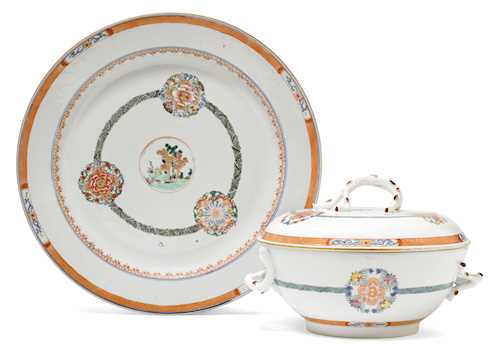
Lot 1211 - A204 Decorative Arts - Thursday, 30. March 2023, 10.00 AM
RARE LIDDED TUREEN AND A TRAY WITH "FAMILLE VERTE" DECORATION
The tureen Meissen, ca. 1730, the tray, China, Kangxi (1662-1722), early 18th century.
Round bowl, the handles and finial designed as a branch. Painted after a Chinese Famille-Verte model with floral rosettes, leaf-wreath borders and an iron-red rim with gold-leaf decoration. The top of the lid with a small phoenix. Blue enamel swords in overglaze on the bottom of the tureen, the tray without mark.
Ø tureen 24 cm, Ø tray 31.5 cm.
The rare decoration of the tureen on offer copies quite exactly a model of the Chinese Famille-Verte style from the Kangxi period. A Meissen saucer "bowl" with this decoration is in the Ernst Schneider Collection in Lustheim. Only a few Meissen examples with this decoration are known, especially tureens are rare (Weber 2013, Vol. II, pp. 384-385, Note 4, Cat. No. 406).
For the shape of the handles, which are naturalistically modeled with knotholes, a form was used that was already known in 1722. Cf. C. Boltz, Die wöchentlichen Berichte über die Tätigkeit der Meissner Dreher und Former vom 6. Juni 1722 bis 31. Dezember 1728, Keramos 178, 2000, pp. 69 and 74.
Since the tureen is marked with the blue enamel swords in overglaze, it provides information about its provenance. It was obviously part of the porcelains that the Parisian wholesaler Rudolphe Lemaire commissioned from the Manufactory between ca. 1729-31, unmarked or also with pseudo-Asian marks (e.g. the caduceus mark), in order to sell them profitably as Asian originals. However, later, Augustus the Strong expressly demanded that Meissen porcelains be marked with the swords so that they could also be recognized as Saxon products abroad. The Manufactory, under Count Hoym's management, initially only used the enamel swords in overglaze, which were relatively easy to remove, such that the fraudulent trade in the pseudo-Asian porcelains continued in Paris, albeit only for a short time; in 1731, the fraud was exposed.
For the shape of the handles, which are naturalistically modeled with knotholes, a form was used that was already known in 1722. Cf. C. Boltz, Die wöchentlichen Berichte über die Tätigkeit der Meissner Dreher und Former vom 6. Juni 1722 bis 31. Dezember 1728, Keramos 178, 2000, pp. 69 and 74.
Since the tureen is marked with the blue enamel swords in overglaze, it provides information about its provenance. It was obviously part of the porcelains that the Parisian wholesaler Rudolphe Lemaire commissioned from the Manufactory between ca. 1729-31, unmarked or also with pseudo-Asian marks (e.g. the caduceus mark), in order to sell them profitably as Asian originals. However, later, Augustus the Strong expressly demanded that Meissen porcelains be marked with the swords so that they could also be recognized as Saxon products abroad. The Manufactory, under Count Hoym's management, initially only used the enamel swords in overglaze, which were relatively easy to remove, such that the fraudulent trade in the pseudo-Asian porcelains continued in Paris, albeit only for a short time; in 1731, the fraud was exposed.
CHF 3 000 / 4 000 | (€ 3 090 / 4 120)
Sold for CHF 9 375 (including buyer’s premium)
All information is subject to change.



